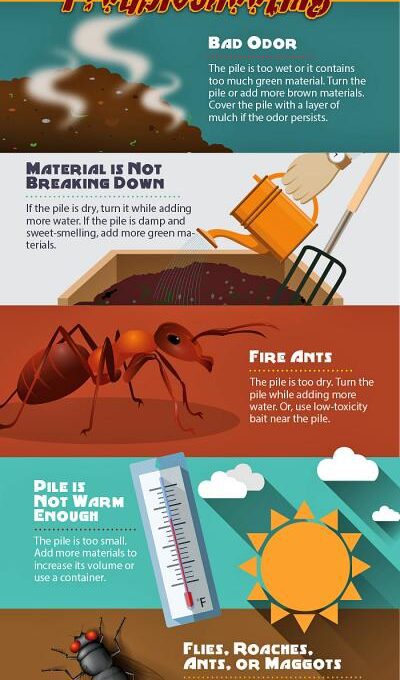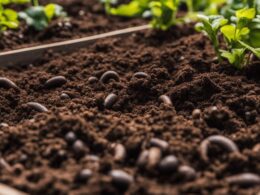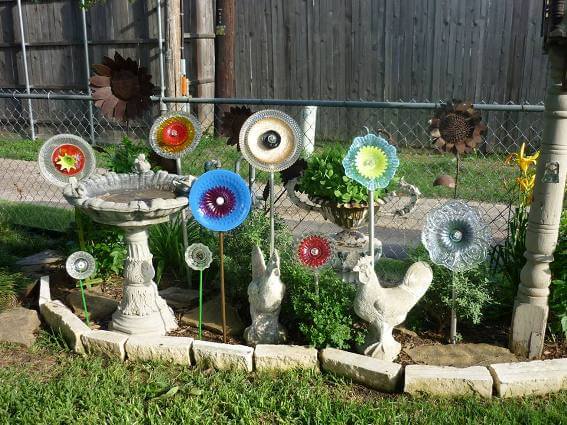We’ve all been there – you’re excited to do your part for the environment by starting a compost pile, but suddenly, you’re hit with that unpleasant smell. You know, the one that makes you want to hold your nose and run away as fast as possible?
Don’t worry; we’ve got your back! In this article, we’ll help you troubleshoot common composting problems related to odor so you can continue being an eco-friendly rockstar without worrying about stinky situations.
It’s important to remember that not everything is a lost cause when it comes to smelly compost piles. With a little bit of knowledge and some handy tips, you’ll be able to tackle those odors head-on and keep your compost smelling fresh (or at least less offensive).
So let’s dive in and find out how to make sure your backyard oasis stays safe from any nasty smells lurking around!
Identifying The Source Of The Smell
When it comes to composting, a little bit of smell is normal. After all, you’re breaking down organic materials like food scraps and yard waste. However, if your compost pile or bin starts to stink more than usual, it’s essential to identify the source of the foul odor. Not only will this help keep your environment smelling fresh, but it also ensures that your compost is healthy and safe for use in your garden.
There are a few common reasons why a compost pile might start to smell bad. One possibility is that there isn’t enough air circulation within the pile. Good airflow is crucial for aerobic bacteria – these are the good guys that break down organic matter without producing any unpleasant odors. If they don’t get enough oxygen because the pile is too compacted or wet, anaerobic bacteria take over, causing a rotten egg smell as they release hydrogen sulfide gas during decomposition.
Another possible cause could be an imbalance between green (nitrogen-rich) and brown (carbon-rich) ingredients in your compost heap – having too many greens can lead to ammonia smells due to excess nitrogen. To eliminate unwanted odors from your compost pile or bin, try turning or fluffing up the contents with a shovel or pitchfork – this adds much-needed oxygen for those helpful aerobic bacteria. You can also balance out your mix by adding more carbon-rich materials like dried leaves, straw, or shredded paper when you notice strong ammonia scents coming from too many nitrogen-heavy greens.
Don’t forget always to cover new additions with some existing finished compost or another layer of browns; doing so helps contain any potential smells while keeping critters at bay! By addressing these issues promptly and maintaining proper conditions in your compost system, you’ll create a safer environment and nutrient-rich soil amendment for your plants without sacrificing comfort in terms of strong odors around you home and garden area , allowing you to enjoy the benefits of composting without any unpleasant side effects. This will not only contribute to the health and beauty of your garden, but also promote a sustainable and eco-friendly approach to waste management.
Properly Balancing Green And Brown Materials
Now that we’ve pinpointed the source of that unpleasant odor, it’s time to take action and restore balance to your compost pile.
One key element in this process is ensuring you have the right mix of green and brown materials. Did you know that a well-balanced compost pile should ideally consist of 25-30 parts carbon (brown materials) to one part nitrogen (green materials)? Having the correct ratio will not only minimize odors but also support effective decomposition.
Brown materials are rich in carbon and include items such as dry leaves, straw, wood chips, and shredded newspaper. Green materials, on the other hand, are high in nitrogen and encompass grass clippings, kitchen scraps like fruit and vegetable peels or coffee grounds, and fresh plant cuttings.
When these two types of materials harmoniously coexist in your compost heap, they create an environment where beneficial microorganisms thrive. These tiny organisms break down organic matter while generating heat – which is essential for killing pathogens and weed seeds – all without releasing any foul smells!
To achieve this optimal state for your compost pile, start by adding more brown material if there’s too much moisture or ammonia-like stench emanating from it. Conversely, if your compost seems overly dry or lacks the necessary heat for efficient decomposition, try incorporating some additional green ingredients into the mix.
Regularly turning over the contents of your pile helps maintain airflow while evenly distributing both types of components throughout its layers. By diligently monitoring conditions within your compost heap and adjusting ingredient ratios accordingly, you’ll be able to prevent future olfactory offenses while creating a nutrient-rich amendment for your garden beds!
Ensuring Adequate Aeration
Now that we’ve tackled the issue of odors in your compost pile, let’s move on to another key aspect of successful composting: aeration.
Ensuring adequate aeration is crucial for maintaining a healthy, balanced compost pile. Proper airflow helps keep unpleasant smells at bay and promotes efficient decomposition by providing oxygen for beneficial microorganisms.
To make sure your compost gets enough air, give it regular ‘turns’ or mixings with a pitchfork or shovel. This will help break up compacted material and create pockets for air to circulate more freely throughout the pile. Aim to turn your compost about once every week or two, depending on its size and content.
It’s also essential to maintain an appropriate balance between green (nitrogen-rich) materials like grass clippings and kitchen scraps and brown (carbon-rich) materials such as leaves and straw in your compost heap. A good rule of thumb is to aim for equal parts green and brown matter – this not only ensures proper nutrient levels but also allows air to flow easily through the mixture.
Don’t be afraid to experiment with different techniques and adjustments based on what works best for you and your unique situation! Remember that keeping safety in mind while addressing any issues along the way can lead you towards achieving a thriving compost ecosystem right in your backyard!
By making sure there’s sufficient space for air circulation within your pile, you’ll enjoy all the benefits of organic waste recycling without any unwanted surprises.
Happy composting!
Addressing Overly Wet Compost
One of the most common problems that can cause a stinky compost pile is having overly wet compost. If you’re dealing with this issue, don’t worry! There are some easy ways to fix it and get your compost back on track.
Wet compost often happens when there’s too much moisture in the pile, which creates an environment where bad-smelling anaerobic bacteria thrive. But by following these simple steps, you’ll be able to restore balance to your compost and keep those unpleasant odors at bay.
First things first: let’s add some dry materials to help soak up all that extra moisture. Brown materials like dried leaves or straw work great for this task because they’re high in carbon and will absorb excess water quickly. Make sure to mix them into the existing compost thoroughly so that these helpful additions do their job effectively. You might need a shovel or pitchfork to turn over the entire pile, but it’s worth it for a better-smelling result!
Another important thing to remember when managing your compost is maintaining proper airflow throughout the pile. Good air circulation helps promote aerobic bacteria (the kind we want), which breaks down organic material without creating any foul smells.
To improve airflow, try turning your compost more frequently – ideally once every week or two – using a pitchfork or shovel. This will introduce oxygen into the mixture while also helping distribute those added brown materials evenly throughout the pile.
With just a bit of effort and attention, you’ll soon have healthier, odor-free compost that’s safe for everyone around!
Managing Excess Nitrogen Content
Is managing excess nitrogen content in your compost a challenge? Don’t worry, you’re not alone! Many people face this issue while composting. The good news is that there are ways to deal with it and maintain a healthy balance in your compost pile.
One common reason for an unpleasant odor coming from your compost is due to high amounts of nitrogen-rich materials like food scraps or grass clippings. This can create an imbalance between the green (nitrogen) and brown (carbon) components of your pile, leading to strong smells.
To fix this, try adding more carbon-based items such as dried leaves or shredded cardboard into the mix. These will help absorb some of the extra nitrogen while also creating air pockets that promote better airflow throughout the pile. Remember, proper ventilation is essential in keeping foul odors at bay!
Don’t forget another simple yet effective way: turning the pile regularly. By doing so, you’ll be mixing all those layers together and allowing oxygen to reach every part of it – which means fewer chances for any bad smell-causing anaerobic bacteria to thrive. So go ahead and give your compost heap a good stir once or twice a week; not only will it reduce odor issues but also speed up decomposition overall!
With these steps in mind, maintaining a well-balanced compost shouldn’t be too much trouble anymore – just remember to keep an eye on what goes into it and adjust accordingly when needed. Happy composting!
Preventing Anaerobic Conditions
One of the main culprits behind smelly compost is anaerobic conditions. When there’s not enough oxygen in your compost pile, it can lead to a slow and stinky decomposition process. But don’t worry, we’ve got you covered with some tips on how to prevent these unpleasant situations.
First things first, make sure your compost pile has a good balance of green and brown materials. Green materials are rich in nitrogen and include things like grass clippings, fruit scraps, and vegetable peelings. Brown materials are high in carbon and consist of items such as leaves, straw, or small branches.
A well-balanced mix allows beneficial microbes to thrive and break down organic matter faster while also providing them with enough air circulation for aerobic decomposition.
Another essential tip is turning your compost regularly. This simple action helps incorporate fresh air into the pile while ensuring all parts get equal access to oxygen. You should aim to turn the heap every week or two using a pitchfork or shovel.
By doing so, you’ll be promoting better airflow throughout the material and keeping those pesky anaerobic bacteria at bay!
Dealing With Pest Infestations
Just like a well-tended garden, your compost pile requires care and attention to thrive. Neglecting it can lead to an unpleasant odor that is not only unbearable but also signals deeper issues within the compost. While dealing with pest infestations can be challenging, taking preventive measures ensures a healthy environment for decomposition.
To maintain harmony in your compost bin, follow these four steps:
-
Regularly turn the contents: Turning over the compost helps aerate the mixture and prevents anaerobic conditions from developing. This allows for better circulation of air and faster degradation.
-
Maintain proper moisture levels: Compost piles should feel damp but not soggy; excess water creates anaerobic conditions which produce foul smells. Be sure to balance wet materials (like food scraps) with dry ones (such as leaves or straw).
-
Layer different types of waste: Layering different kinds of organic matter will encourage various decomposers to work together more efficiently. A good rule of thumb is to alternate between green (nitrogen-rich) and brown (carbon-rich) layers.
-
Add lime or calcium: These substances help neutralize acidity and deter pests such as flies, rodents, or raccoons attracted by strong odors.
By implementing these strategies consistently throughout your composting journey, you are creating a safe haven where beneficial organisms working tirelessly behind-the-scenes remain undisturbed by pesky invaders seeking refuge in their domain.
Maintaining this delicate ecosystem ultimately rewards you with rich, nutrient-filled soil – nature’s gift that keeps on giving! So persevere through any challenges encountered while tending to your compost pile; armed with knowledge and determination, victory lies just around the corner – one aromatic scoop at a time!
Maintaining Appropriate Ph Levels
One of the key factors in keeping your compost pile odor-free is maintaining appropriate pH levels. When the acidity or alkalinity of your compost becomes unbalanced, it can lead to unpleasant smells and hinder the decomposition process. Fear not! You can easily manage these levels and keep your compost healthy and thriving.
To begin with, let’s understand what pH actually is. It stands for ‘potential hydrogen’ and refers to a scale that measures how acidic or basic a substance is on a range from 0 to 14. A pH level of 7 indicates neutrality, while lower numbers are more acidic and higher ones are more basic (alkaline).
Compost piles typically work best at a slightly acidic to neutral pH level, around 6-7. If you find that your compost has an off smell or isn’t breaking down properly, testing its pH could be helpful in identifying the issue.
You’ll need some simple equipment like pH test strips or a digital meter to measure the acidity of your compost pile. Before taking any measurements, remember to mix up your pile well so that you get an accurate reading.
Once you have determined if your compost is too acidic or too alkaline, adjusting the balance is relatively easy by adding specific materials into the mix. For example, if your pile’s pH is too low (acidic), try adding crushed eggshells or wood ash which will help raise it back towards neutral levels. On the other hand, if it’s too high (alkaline), add leaves, straw, or sawdust as they will bring down the alkalinity over time.
Being mindful of this balance will go a long way toward ensuring both safety and success in creating nutrient-rich soil for your garden!
Adjusting The Size Of The Compost Pile
Just like a master chef balances flavors in a dish, maintaining the right balance in your compost pile is essential for avoiding unpleasant odors. If you’ve fine-tuned the pH levels and still find yourself with a smelly mess, it’s time to look at other factors that might be causing these olfactory offenses.
Adjusting the size of your compost pile can make all the difference in keeping those stenches at bay. A well-balanced compost pile should create an environment where beneficial microbes thrive while breaking down organic material without releasing foul smells.
To achieve this harmony, consider implementing these three changes:
-
Keep the height and width of your compost pile between 3-5 feet.
-
Turn or mix the contents regularly to ensure an even distribution of materials and air circulation.
-
Add more dry materials such as leaves, straw, or shredded paper if your pile becomes too wet.
By following these simple guidelines, you’ll provide a safe haven for microorganisms to work their magic while ensuring unwanted odors don’t escape into your surroundings. Remember that consistency is key – turning your pile often and monitoring its moisture content are crucial steps towards creating rich, earthy-smelling compost rather than a malodorous mound.
So grab that pitchfork and give those hardworking microbes some room to breathe; they’ll reward you with nutrient-rich humus perfect for nourishing your plants!
Can Odor Issues Be Prevented When Composting?
Can odor issues be prevented when composting? Absolutely! Following a beginner’s guide to composting is the key. Properly balancing the carbon-rich browns (like dried leaves) with nitrogen-rich greens (like kitchen scraps) reduces the likelihood of odors. Proper aeration and moisture control also promote decomposition without the foul smells.
Controlling Temperature And Humidity
After tackling the issue of odor in your compost, it’s essential to focus on controlling temperature and humidity. These factors play a crucial role in ensuring that your compost pile breaks down efficiently and remains healthy. Don’t worry; keeping an eye on these aspects isn’t as challenging as you might think!
Firstly, let’s discuss temperature. A well-functioning compost pile should heat up to about 130-160 degrees Fahrenheit (55-70 degrees Celsius). This warmth is vital for killing off any harmful pathogens or weed seeds present in the compost materials while allowing beneficial microorganisms to thrive.
To maintain this ideal temperature range, turn your compost regularly using a pitchfork or shovel. Turning helps aerate the pile, which provides necessary oxygen for decomposition and keeps those helpful microbes happy.
Now, onto humidity! Your compost should have a moisture content similar to a damp sponge – not too dry but also not sopping wet. Too much water can cause unpleasant odors and slow down decomposition, while too little can prevent microbes from breaking down materials effectively.
Keep track of rainfall and adjust watering accordingly if needed. You can also cover your compost bin with a tarp during heavy rainstorms to protect it from excess water. For drier weather conditions, add some moistened leaves or grass clippings to help retain moisture within the pile.
By paying attention to both temperature and humidity levels in your compost heap, you’ll ensure its success while keeping potential problems at bay!
Utilizing Odor-Reducing Additives
When composting, odor can become a problem. Fortunately, there are odor-reducing additives that can help.
Some of the most common types are enzymes, vinegar, and baking soda. These additives have some great benefits, like neutralizing odors, preventing mold growth, and improving air quality.
They can be easily applied by sprinkling them on the compost pile, or by adding them to the compost bin. By using odor-reducing additives, composters can get the most out of their composting journey!
Types Of Odor-Reducing Additives
Isn’t it amazing how a few simple ingredients can make all the difference in your compost pile? Odor-reducing additives are here to save the day, and with so many options available, you’re sure to find one that works for you.
Let’s dive into three types of additives that’ll help keep those nasty smells at bay.
First up is zeolite, which is a natural volcanic mineral known for its ability to absorb moisture and neutralize odors. When added to your compost pile, this wonder-mineral acts like a sponge, soaking up any excess water while also trapping foul-smelling gases. Worried about safety? No problem! Zeolite is non-toxic and environmentally friendly – perfect for keeping your garden fresh and healthy.
Another popular option is biochar – an organic compound made from burning wood or other plant materials in low-oxygen conditions. This charcoal-like substance helps reduce odor by improving air circulation within the pile and promoting beneficial microbial activity. Plus, it has been shown to enhance soil fertility once mixed into your garden beds!
Now go ahead and enjoy some peace of mind knowing that not only have you reduced unpleasant odors but also contributed positively to the environment.
Benefits Of Odor-Reducing Additives
So, you might be wondering what’s in it for you when using these odor-reducing additives. Well, let us tell you! These fantastic ingredients not only help with keeping your compost pile smelling fresh but also offer some great benefits to both your garden and the environment.
That’s right; by simply adding zeolite or biochar into the mix, you’re making a significant impact on Mother Earth.
Firstly, improving air circulation within your compost pile means that aerobic bacteria can break down organic matter more efficiently – which is excellent news for those of us who want nutrient-rich soil for our plants to thrive in.
Plus, reducing odors makes maintaining a compost pile much more pleasant (and neighbor-friendly). Nobody wants their backyard oasis tainted by unpleasant smells, right?
And don’t forget about the environmental perks! By promoting healthy microbial activity in your compost pile, you’ll reduce methane emissions – one of the major greenhouse gases contributing to climate change.
So go ahead and pat yourself on the back because while keeping your garden happy and safe from nasty odors, you’re playing an essential part in protecting our planet too!
Application Of Odor-Reducing Additives
Now that you know the fantastic benefits of using odor-reducing additives like zeolite and biochar, you’re probably eager to learn how to apply them in your compost pile. Don’t worry; it’s super easy! You don’t need a green thumb or any fancy equipment – just follow some simple steps, and soon enough, you’ll be on your way to creating an odor-free, nutrient-rich haven for your garden while keeping everything safe and sound.
To start with, all you have to do is sprinkle these powerful additives evenly across the top of your compost pile or mix them directly into the layers as you build it up. Remember, moderation is key here – too much of anything can throw off the balance needed for efficient decomposition. So make sure not to go overboard when adding these materials.
It’s always best to consult online resources or reach out to fellow gardening enthusiasts if you’re unsure about the right amount. As time goes by, keep an eye on how things are progressing in your compost pile. If odors persist or become more intense, give it another boost with these amazing additives until everything smells fresh again – but remember to stay patient since good things take time!
With proper application and maintenance, there’s no doubt that utilizing odor-reducing additives will contribute significantly towards a healthier environment for both your garden and our planet as a whole.
Monitoring And Regularly Turning The Pile
Picture a thriving garden, brimming with vibrant flowers and robust vegetables. The key ingredient to this lush scene is rich, fertile compost.
To maintain your compost pile’s health and prevent unpleasant odors, it’s essential to monitor its progress and turn the materials regularly. Monitoring and turning your compost pile helps ensure proper temperature, adequate oxygen levels, balanced moisture content, and even decomposition.
A well-maintained pile will generate heat as organic material decomposes. Turning introduces necessary air into the mix for aerobic bacteria to thrive. Regular mixing prevents excess water from pooling at the bottom of the bin. Consistent turning ensures all ingredients break down uniformly.
To keep you and your neighbors feeling secure in the knowledge that odors are under control, make sure to check on your compost pile every few days or so. Use a thermometer to measure temperatures within different parts of the heap; ideally, they should range between 130°F (54°C) -160°F (71°C). If needed, adjust the number of green (high-nitrogen) and brown (carbon-rich) materials accordingly.
Remember to give your pile a good stir by using a pitchfork or shovel each time you add new components. This action not only maintains optimal conditions but also serves as an opportunity for you to gauge its texture – neither too dry nor overly soggy – which contributes immensely toward controlling those pesky smells!
Frequently Asked Questions
Can The Type Of Compost Bin Or System Used Affect The Odor Of The Compost Pile?
Absolutely, the type of compost bin or system you use can impact the odor of your compost pile.
Choosing a well-designed and properly ventilated bin can help minimize any unpleasant smells that might make you feel uneasy.
Many people opt for bins with lids or covered systems to keep unwanted critters away and contain potential odors.
Remember, maintaining a good balance of ‘green’ (nitrogen-rich) and ‘brown’ (carbon-rich) materials in your compost mix will also play a significant role in controlling those funky smells, ensuring a safer and more enjoyable experience when tending to your eco-friendly project.
How Often Should I Check The Moisture Levels Of My Compost Pile To Prevent Unpleasant Odors?
Just as Goldilocks sought the perfect bowl of porridge, finding the right moisture balance in your compost pile is crucial to prevent unpleasant odors.
To ensure a safe and enjoyable composting experience, it’s essential to check the moisture levels at least once a week.
A well-maintained compost pile should feel like a damp sponge when you give it a gentle squeeze.
If it’s too dry or too wet, simply adjust by adding water or more brown materials such as leaves or straw.
By keeping an eye on this delicate balance, you’ll be able to create nutrient-rich compost while avoiding any stinky surprises!
Can Adding Certain Types Of Food Waste To The Compost Pile Contribute To Increased Odors? If So, Which Ones Should Be Avoided?
Absolutely, adding certain types of food waste to your compost pile can contribute to increased odors.
To keep things smelling fresh, it’s best to avoid meat, bones, fish scraps, dairy products, and oily or greasy foods. These items decompose slowly and attract unwanted pests like flies and rodents. Plus, they’re more likely to produce foul smells as they break down.
By sticking to fruit and vegetable scraps, coffee grounds, eggshells, and other plant-based materials in your compost heap, you’ll help ensure a pleasant-smelling process that feels safe for both you and the environment around you!
Are There Specific Seasonal Factors That Can Contribute To Increased Odors In The Compost Pile, And How Can These Be Managed Effectively?
Seasonal factors can definitely play a role in increasing odors from your compost pile.
During warmer months, the heat and humidity can cause the pile to break down faster, which may lead to stronger smells. To manage this, make sure you’re turning your compost regularly for proper aeration and adding more brown materials like leaves or straw to balance out the green food waste.
In colder seasons, decomposition slows down and might cause unpleasant odors as well. In this case, try insulating your compost with extra layers of brown material or even covering it with a tarp to trap warmth inside.
By adjusting your composting methods according to the season, you’ll be able to keep those stinky smells at bay while maintaining a healthy and safe environment for both you and Mother Nature!
Can The Location Of My Compost Pile In My Yard Affect Odor Levels, And What Is The Optimal Placement For Minimizing Unpleasant Smells?
Imagine your backyard as a kingdom, and you are the ruler who must strategically place the royal compost pile to keep the subjects happy and free from unpleasant odors.
The location of your compost pile can indeed affect odor levels, so choosing an optimal spot is crucial for maintaining harmony in your realm.
To minimize those pesky smells, consider placing your compost pile away from windows or doors leading into your home, ideally downwind so that any whiffs are carried away.
Additionally, ensure good air circulation by keeping it clear of walls or fences, as this will help speed up decomposition and reduce odor-causing anaerobic bacteria.
By thoughtfully positioning your compost heap, you’ll not only create a more pleasant environment but also protect the safety and happiness of everyone within your yard’s borders!
Conclusion
In conclusion, taming the wild beast of compost odor can feel like a Herculean task.
Fear not, fellow gardeners! By paying attention to your bin type, moisture levels, food waste choices, seasonal factors and location placement, you’ll be well on your way to conquering this smelly foe.
Remember that Rome wasn’t built in a day; it takes time and patience to perfect your composting techniques.
Keep experimenting and learning from mistakes, and soon enough you’ll have an odor-free paradise in your own backyard.









